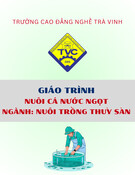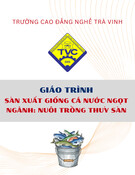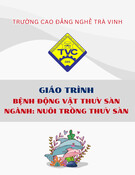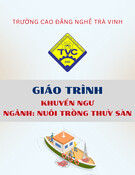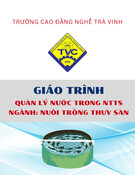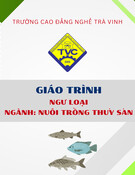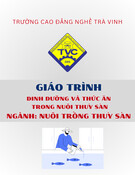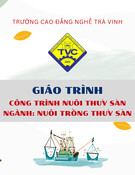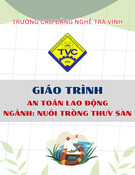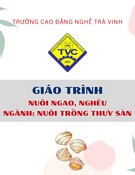
Vietnam Journal
of Agricultural
Sciences
ISSN 2588-1299
VJAS 2022; 5(4): 1645-1659
https://doi.org/10.31817/vjas.2022.5.4.04
https://vjas.vnua.edu.vn/
1645
Received: January 22, 2022
Accepted: December 26, 2022
Correspondence to
hlphuong@vnua.edu.vn
Phenolic Extracts from Myrtaceae Leaves
Improve the Quality and Shelf-life of Pacific
Whiteleg Shrimp
Lai Thi Ngoc Ha, Tran Thi Hoai, Nguyen Van Lam & Hoang Lan
Phuong*
Faculty of Food Science and Technology, Vietnam National University of Agriculture,
Hanoi 131000, Vietnam
Abstract
This study aimed to quantify the phenolic contents and the
antioxidant capacities of leaf extract powders from three Myrtaceae
plants, namely Cleistocalyx operculatus (Vietnamese name: Vối),
Psidium guajava (Ổi), and Rhodomyrtus tomentosa (Sim),
investigate their inhibitive activities on the growth of bacteria
isolated from spoiled shrimps, and evaluate their values as
preservative agents in the cold storage of Pacific whiteleg shrimps
(Penaeus vannamei). The extract leaf powders from R. tomentosa, C.
operculatus, and P. guajava had high phenolic contents of 281.25,
282.36, and 349.51 mg gallic acid equivalent/g leaf extract,
respectively. Among the three plants, the extract powders of R.
tomentosa and P. guajava leaves had the highest antioxidant
capacities (about 4 mmol Trolox equivalent (TE)/g) followed by the
one of C. operculatus (2.85 mmol TE/g). These three extract powders
showed significant antibacterial activities against the seven bacteria
isolated from cold-stored spoiled whiteleg shrimps with the
inhibition zones ranging from 0.33 to 19.67mm depending on the
extract concentration. Among the three leaf extracts, the one from P.
guajava leaves showed the highest inhibitive activity. Aeromonas sp2
was the most sensible to Myrtaceae leaf extracts while Aeromonas
sp4 was the least affected strain. All the extracts showed high
inhibitive activities against melanosis, volatile nitrogen-containing
compounds formation, lipid oxidation, and microbial growth in
stored shrimps, thereby prolonging the shelf-life of the shrimps. The
results suggested the potential application of these three Myrtaceae
plants as sources of antioxidant and antimicrobial agents in the cold
storage of shrimps.
Keywords
Phenolic compounds, antioxidant capacity, antimicrobial activity,
cold storage.

Phenolic extracts from Myrtaceae leaves improve the quality and shelf-life of Pacific whiteleg shrimp
1646
Vietnam Journal of Agricultural Sciences
Introduction
Pacific whiteleg shrimp (Penaeus vannamei)
is an economically important crustacean in
Vietnam thanks to its high and increasing
production (480.0 and 632.3 thousand tons in
2019 and 2020, respectively) (Vietnamese
Directorate of Fisheries, 2019; 2020). This high-
value crustacean is very perishable, and their
quality and freshness rapidly decrease during
post-mortem handling and storage due to
spoilage bacteria contamination, hydrolysis
catalyzed by endogenous/exogenous protease,
and melanosis (Manheem et al., 2013). Indeed,
the number of spoilage bacteria increases rapidly
and this leads to the acceleration of protein
decomposition and off-odour of shrimps (Qian et
al., 2013). According to da Silva et al. (2015),
Pseudomonas sp. and Aeromonas sp. have been
found as the main strains of spoiling shrimps in
cold conditions. Besides the negative impacts of
bacteria, melanosis also reduces the quality of
shrimps during storage. This biochemical
reaction negatively affects the sensorial quality
of shrimps and results in reducing their shelf-life.
In order to inhibit melanosis and bacterial
growth in stored shrimps, chemical agents such
as sulfite derivatives and phosphates have been
used (Gómez-Guillén et al., 2005). However,
the use of synthetic compounds is often limited
due to their side effects. For example,
metabisulphite (E223) has been considered to be
responsible for asthma attacks and the cause of
serious allergic reactions in people who are
exposed to it (Collins-Williams et al., 1983).
Because of the potential health hazards of
chemical additives, natural products, especially
natural antioxidants and antimicrobial agents,
have been intensively examined as safe
alternatives to synthetic compounds.
Phenolic compounds are known as the most
common secondary plant metabolites (Alara et
al., 2021) with about 10,000 phenolic structures
currently known (Kennedy & Wightman,
2011). In food technology, phenolic
compounds can be considered as natural
preservatives resulting from their important
biological properties including antioxidant and
antimicrobial activities.
Research has been done on the potential
application of natural extracts to extend the shelf-
life of seafood. According to Miraglia et al.
(2020), a phenolic extract derived from olive
vegetation water at a concentration of 2 g L-1 led
to a significant reduction in total volatile basic
nitrogen, thiobarbituric reactive substances
values, bacterial growth, and black spot
formation on shells in deep-water rose shrimps
(Parapenaeus longirostris) stored at 2oC. In
another study, treating Indian white prawns
(Fenneropenaeus indicus) with green tea and
amla (Phyllanthus emblica Linn) extracts
significantly lowered some biochemical indices,
aerobic bacterial counts, and polyphenol oxidase
activity during 28 days of chilled storage
compared to untreated samples (Firdous et
al., 2020).
Although the use of phenolic extracts as
natural preservatives for shrimp storage have
been reported for several plants around the
world, the benefits of phenolic extracts from
Vietnamese plants is still limited. Our recent
screening study indicated that among 12
potential Vietnamese medicinal plants, three
Myrtaceae plants, namely Cleistocalyx
operculatus (Vối), Psidium guajava (Ổi), and
Rhodomyrtus tomentosa (Sim), had the highest
antioxidant and antimicrobial activities (data not
published). Hence, in this study, we aimed to
evaluate the preservative potential of leaf extract
powders from these three Myrtaceae plants
during the cold storage of Pacific whiteleg
shrimps. In order to achieve this goal, firstly, the
antibacterial activities of the leaf extracts against
seven bacteria isolated from cold-stored spoiled
whiteleg shrimps were determined. Then,
shrimps were treated with different
concentrations of the extracts and stored under
cold conditions. During storage, biochemical
and microorganism changes in the shrimps
were followed.
Methodology
Chemicals
Gallic acid, 6-hydroxy-2,5,7,8-
tetramethylchroman-2-carboxylicacid (Trolox),
diphenyl-1-picrylhydrazyl (DPPH) radical,

Lai Thi Ngoc Ha et al. (2022)
https://vjas.vnua.edu.vn/
1647
thiobarbituric acid (TBA), and antifoam 204
were purchased from Sigma-Aldrich (St. Louis,
MO). Malondialdehyde bis was produced by
Chemservice (West Chester, PA). Ethanol,
methanol, glucose, boric acid, sodium hydroxide,
sodium metabisulfite (SMS), potassium chloride,
chlorhydric acid, calcium chloride, sodium
carbonate, sodium chloride, dimethyl sulfoxide
(DMSO), and sodium hypochlorite were of
analytical grade and were produced by the
Xilong Company (Guangdong, China). Agar,
yeast extract and peptone, and perchloric acid
were made by the Hai Long Company (Hai
Duong, Vietnam), Titan Biotech Limited (Delhi,
India), and Guangzhou Fischer Chemical
(Guangzhou, China), respectively. Tryptic Soya
Agar medium and tryptone were purchased from
Scharlau (Spain).
Leaf collection and preparation of the extract
powders
Leaves of three Myrtaceae plants, namely C.
operculatus, P. guajava, and R. tomentosa, were
harvested in Hanoi and Quang Ninh provinces in
August 2016. Plants were identified at the
species level as R. tomentosa, C. operculatus,
and P. guajava by morphologic comparisons of
leaves, buds, flowers, and fruits based on the
descriptions of Pham Hoang Ho (2003). All
leaves were first washed with tap water and
rinsed in distilled water. They were then dried in
an oven at 50oC for 15h and ground into fine
powders with particle sizes less than 0.3mm
by using a Tecator Cyclotec 1093 Sample Mill
(Foss A/S, Denmark). The leaf powders were
stored in airtight containers and kept at 4oC until
further use.
Extraction was done with an aqueous ethanol
solution and a solid/liquid ratio of 1/10. For C.
operculatus and P. guajava leaves, 100g leaf
powder was added to 1L of ethanol 70% (v/v).
Extraction was carried out for 30min at room
temperature. For R. tomentosa leaves, the
extraction was done by using the conditions
optimised by Ha et al. (2016) (ethanol 40% (v/v)
at 90oC for 15min). After extraction, the mixtures
were centrifuged at 3642xg for 10min at 4oC. The
supernatants were then concentrated by using a
R210 rotary evaporator (Buchi, Switzerland)
under reduced pressure at 40oC and dried by
using a Modulyo freeze dryer (Thermo Fisher
Scientific, MA). The extract powders were stored
at 4oC in plastic bags for further studies.
Bacteria
Seven bacterial strains were isolated from
cold-stored spoiled whiteleg shrimps at the
Faculty of Aquaculture (Vietnam National
University of Agriculture - VNUA). They were
characterized as members of the Aeromonas (six
strains named Aeromonas sp1 - 6) and
Pseudomonas (one strain named Pseudomonas
sp) genera basing on morphological observations
(cell form, colony form, and color), and
physiological (mobility) and biochemical tests
(Gram staining; oxidase, catalase, amylase tests;
fermentation of glucose, maltose, and lactose;
H2S production; growth on Nutrient Agar and
Thiosulfate-Citrate-Bile Salts-Sucrose media).
Determination of the total phenolic content
The total phenolic contents of the extract
powders were determined by using the Folin-
Ciocalteu reagent as described by Singleton &
Rossi (1965). First, the extract powder was
dissolved in ethanol 70% (v/v) to obtain a
concentration of 50 mg mL-1. An aliquot of
0.5mL of the diluted extract was mixed with
0.25µL of 1 N Folin-Ciocalteu reagent. The
mixture was shaken and allowed to react over a
period of 5min. Then, 1.25mL of 7.5% Na2CO3
was added and the mixture was mixed
thoroughly. After incubation for 30min, the
absorbance of the reaction solution was
measured at 755nm by using a UV-1800 UV-VIS
spectrophotometer (Shimadzu, Japan). Gallic
acid was used as the standard for building the
calibration curve. The total phenolic content of
each extract powder was expressed as mg of
gallic acid equivalents per gram extract
(mg GAE/g).
Determination of the antioxidant capacity
The antioxidant capacities of the extract
powders were measured by the DPPH radical
scavenging test according to Duan et al. (2007)
with minor modifications. Briefly, 100µL of the
diluted extract was added to 2,900µL of 0.1mM

Phenolic extracts from Myrtaceae leaves improve the quality and shelf-life of Pacific whiteleg shrimp
1648
Vietnam Journal of Agricultural Sciences
free radical DPPH in methanol. The mixture was
shaken vigorously and incubated at room
temperature for 30min in the dark. The
absorbance of the resulting solution was then
measured at 517nm. The control contained
methanol instead of the sample solution. The
inhibition of the DPPH radical by the sample was
calculated according to the following equation:
DPPH-scavenging activity (%) =
100*(Acontrol - Asample)/ Acontrol.
Trolox was used as the standard. The
antioxidant capacity was expressed in mmol Trolox
equivalents per gram extract (mmol TE/g).
In vitro antimicrobial activity test
The antimicrobial activities of the three
extract powders were measured by using the agar
well diffusion method designed by Dang et al.
(2019) with small modifications. Firstly, seven
bacterial strains isolated from cold-stored spoiled
whiteleg shrimps were taken from stocks and
activated by being streaked on Petri dishes
containing Tryptic Soya Agar (for Aeromonas
sp.) or Luria-Bertani (for Pseudomonas sp.)
media. The dishes were incubated at 37oC in an
incubator for 24h. After incubation, single
colonies of each strain were selected,
individually transferred to corresponding liquid
media, and then incubated at 37oC in a shaking
incubator (200rpm) for 15 hours to reach the
stationary growth phase.
One hundred microliters of each bacterial
culture, adjusted to a microorganism
concentration of 108 colony-forming units per
mL (CFU/mL), was spread on a Petri dish
containing 25mL of their specific media. The leaf
extract powders were dissolved in 10% DMSO
to make concentrations of 10, 20, 30, 40, 50, and
75 mg mL-1 for the antibacterial activity test. One
hundred microliters of each extract solution at
different concentrations were added to the test
wells, while the control well consisted of 100µL
of 10% DMSO. The Petri dishes were kept at 4oC
for 2 hours and then incubated at 37oC for 18
hours. After incubation, the zone of inhibition
was measured as the difference between the
diameter of the inhibition zone surrounding the
well and the diameter of the well (8mm).
Shrimp treatments
About 20kg of fresh Pacific whiteleg
shrimps, 35-45 shrimps kg-1 in size, were
purchased from a supermarket in Hanoi. The
shrimps were kept in ice with a shrimps/ice ratio
of 1:2 (w/w) and transported to the Faculty of
Food Science and Technology, VNUA. Upon
arrival, the shrimps were washed in cold, sterile
water before treatment.
The three leaf extract powders were
dissolved in distilled water. Whiteleg shrimps
were treated with one of three treatments: 0%
(control), 0.25%, and 0.5% (w/v). Briefly,
whiteleg shrimps were immersed into one of the
plant extract solutions with a shrimps/solution
ratio of 1:2 (w/v) at 4°C for 30min. For the
controls, the whiteleg shrimps were soaked in
1.25% SMS (positive control) or were treated
with distilled water (negative control). After
immersion, the whiteleg shrimps were drained at
ambient temperature for 3min. Five shrimps
were placed in a tray with plastic cover. All the
trays were placed in a refrigerator at a
temperature of 1-4oC. Samples were taken every
two days over a 12-day period. At the sampling
time, three trays from each treatment were taken
and the shrimps were analyzed for firmness,
melanosis assessment, pH, total volatile bases
nitrogen (TVB-N) value, thiobarbituric acid
reactive substances (TBARS) value, and total
microbial count. A total of 168 trays (= 8
treatments*7 sampling times*3 biological
replications) were prepared and stored.
Shrimp quality analysis
Melanosis analysis: Melanosis of whiteleg
shrimps was evaluated through visual inspection
by six trained panelists using the 10-point
scoring method described by Nirmal & Benjakul
(2011). Samples were analyzed once.
Texture analysis: The texture analysis of
shrimp muscle was performed by using an
Agrosta 14 Digital Firmness Tester (Agro
Technologies, France). An eight-mm diameter
flattened cylinder was used. A constant
penetration depth of 2mm was applied on the
whiteleg shrimp muscle and the force was
recorded. Measurements were taken on

Lai Thi Ngoc Ha et al. (2022)
https://vjas.vnua.edu.vn/
1649
three different parts of three individual
shrimps per sample.
pH measurement: The pH of shrimp muscle
was determined using the protocol described by
Tsironi et al. (2009) with small modifications.
Briefly, 5g of shrimp flesh was transferred to a
plastic tube and 45mL of Ringer solution was
added. The mixture was homogenized for 60s.
The pH of this homogenized sample was
measured by using a pH meter (Thermo
Scientific, Singapore).
TVB-N value: The TVB-N value of the
shrimp flesh was determined by the protocol
described in the European Commission
guidelines (Commission Decision 95/149/EC,
1995), which fixes the TVB-N limit values for
certain categories of fishery products and
specifies the analytical methods to be used.
Analyses were conducted by distillation in a
Vapodest 30s machine (Gerhardt, Germany)
and titration with HCl 0.01 N.
Malondialdehyde (MDA) content was
determined by using the method described by
Tsironi et al. (2009). TBARS values
were calculated from the standard curve of
malondialdehyde (0-10 µmol L-1) and
expressed as mg malondialdehyde/kg
shrimp flesh.
Bacteria count: The total plate count of
shrimps was determined by using the protocol
described by Kalleda et al. (2013) with minor
modifications. Briefly, two whole whiteleg
shrimps were aseptically collected and used as
the composite sample. A representative ground
sample (25g) was transferred to a sterile conical
flash with 225mL of sterile water containing 1%
peptone and 0.85% NaCl, and homogenized for
1min with a T10 basic Ultra-turrax (IKA,
Germany). Samples (0.1mL) of 10-fold
appropriate dilutions of the shrimp homogenates
were spread on the surface of the Plate Count
Agar media in Petri dishes. The dishes were
incubated at 37oC for 48h.
Statistical analysis
Data were analyzed using the statistical
software SAS 9.4 (SAS Institute, Cary, NC). The
zone of inhibition was expressed as the mean ±
standard deviation of three experimental
replications. Analysis of variance was carried out
using a generalised linear model (GLM)
procedure to determine (1) the effects of the plant
source, extract concentration, and bacterial strain
as well as their interactions on the zone of
inhibition, and (2) the effects of the type of
treatment and storage time as well as their
interaction on the index of quality of shrimps.
Results and Discussion
Total phenolic content and antioxidant
capacity of the extract powders
The polyphenol contents of the extract
powders were relatively high and ranged from
281.25 ± 0.75 to 349.41 ± 0.72 mg GAE/g
(Table 1). The extract of P. guajava had the
highest phenolic content (349.41 ± 0.72 mg
GAE/g) followed by the extracts of C.
operculatus (282.36 ± 1.17 mg GAE/g) and R.
tomentosa (281.25 ± 0.75 mg GAE/g). These
figures were similar to the phenolic contents of
extracts made from lyophilised leaves, bark,
and whole plants of four medicinal plants from
Burkina Faso, namely Combretum
micranthum, Khaya senegalensis, Pterocarpus
erinaceus, and Sida acuta (284.2-378.0 mg/g
extract) (Karou et al., 2005).
In comparison with other medicinal plants,
the three Myrtaceae plants in the present study
had higher phenolic contents in the extracts.
Table 1. Total polyphenol contents and antioxidant capacities of the three extract powders
Leaf extract powder
Polyphenol content
(mg GAE/g)
Antioxidant capacity
(mmol TE/g)
R. tomentosa
281.25 ± 0.75
4.00 ± 0.07
P. guajava
349.41 ± 0.72
3.99 ± 0.19
C. operculatus
282.36 ± 1.17
2.85 ± 0.17
Note: n = 3 analysis replications.

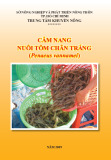
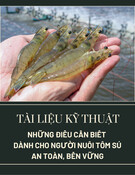

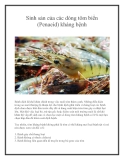
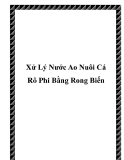
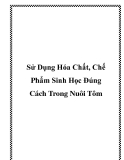

![Quy trình nuôi tôm sú, tôm thẻ chân trắng thâm canh, bán thâm canh [chuẩn nhất]](https://cdn.tailieu.vn/images/document/thumbnail/2013/20130612/titungnp/135x160/1494384_158.jpg)
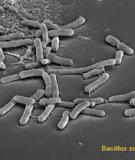
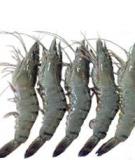
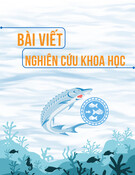
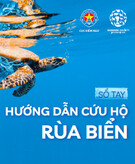
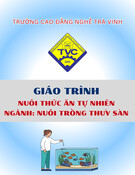
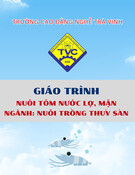
![Giáo trình Sản xuất giống tôm nước lợ, mặn (Trung cấp/Cao đẳng) - Trường Cao đẳng nghề Trà Vinh [Mới nhất]](https://cdn.tailieu.vn/images/document/thumbnail/2025/20251115/kimphuong1001/135x160/76031763179346.jpg)
